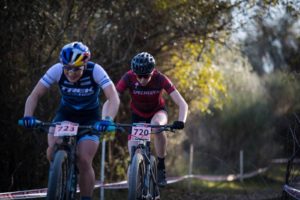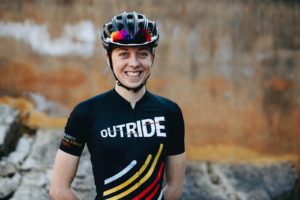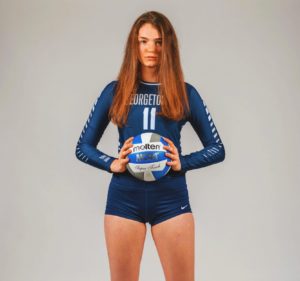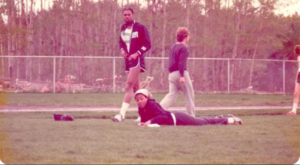Written by Makenna Reilly
Haley Batten has been a mountain biker for practically her entire life, and over the past few years, she has become one of the top US racers (Learn more here). Yet being an elite athlete is never easy, and for Haley, the challenges go beyond the normal bumps in the road.
A few years ago, Haley was diagnosed with a breathing issue known as Exercise-Induced Laryngeal Obstruction (ELIO) or Vocal Cord Dysfunction (VCD). EILO is a condition that, during strenuous activity, causes a person’s vocal cords to close inwards, making it incredibly difficult to breathe and often leading to hyperventilation or blackouts. EILO makes it extremely hard for athletes to reach peak performance, and there is no treatment. The only alternative is to try to prevent or minimize attacks by utilizing different breathing techniques and stress management exercises.
Being an athlete with EILO myself, I can attest to the incredible challenge it presents, not only to physical performance, but to hopes, dreams, and even identity. Yet the unique struggle presented by this condition makes it even more inspiring to see athletes such as Haley striving to learn and grow from the challenge, and moving forward by courageously pursuing what they love.
But Haley’s story is not just a narrative of events, it is a message for all athletes about how, regardless of the exact challenge, adversity is a chance to grow and an opportunity to reconnect with what you love and the reasons you love it. It is a chance to see that the pieces of yourself that don’t necessarily fit with your version of the perfect athlete, may not be a weakness, but a beautiful uniquity that allows you to stand apart from every other person as yourself.
Haley explains that “We have big goals when we are young, and we know what we want to achieve in sports specifically, but finding out I have EILO threw a glitch in my plan.” We all know that feeling of chasing a dream—it’s what motivates us to work hard every practice and to compete with every bit of strength that we have. But with EILO those achievements become more complicated. Performance-wise, “I would be crushing it in the early season […] and then all of the sudden I would go from podium to racing really trying to get in the top 20.” Because of the largely uncontrollable nature of this breathing condition, Haley would start her season feeling invincible, but not even a few weeks later she would find herself facing “the fight of [her] life.”
Unpredictability is hard because you never really know what the future will look like, and it is even harder for athletes who are always chasing specific goals. “You have this plan for yourself—you want to achieve specific results, or have some performances at a certain time—” but when your breathing changes spontaneously from good to bad, it becomes hard to tell whether or not your work is paying off.
Uncertainty is particularly harmful when so many athletes have expectations of perfection placed on them by people close to them and even by themselves. “We compare ourselves to this perfect version that nobody is” and when things get hard, we push ourselves because we are constantly “wanting to prove [ourselves] so badly.” Particularly, when you are injured, it can feel like “gosh, nobody else is hurt, everyone is training super hard, and I can’t… so now I’m behind,” and with EILO that experience shows up every day. Whenever your breathing forces you to stop training for the day, it feels like you are failing to keep up with other people, but also failing to keep up with your preconceived notions of where you should be or what you should be able to achieve. Setting goals for the future is important for making progress, but “having those expectations hurts emotionally when things aren’t going well.”
There will be times where we don’t have the race we want or where we miss a training day. Falling short of expectations is unavoidable. However, once we miss that mark, it is important to consider how we react. “My EILO has taught me to slow down and stop worrying. I am working on accepting that this is how I am and now I just need to prepare the best I can with that in mind.” Haley’s EILO has inspired her to explore areas of training beyond physical activity that enable her to tackle her breathing problems but also become more of an all-around healthy athlete. “All of the things that help me manage my breathing would help any athlete: sleeping well, managing allergies, eating well to help avoid extra inflammation or so that the body isn’t fighting anything else, fully recovering from injuries, keeping periods and hormones in balance [and] mental and breathing exercises.” Looking back on these valuable skills she has learned and incorporated into her athletic life, she says “Honestly, I don’t know what else could have motivated me and pushed me to do that.” Although competing with this condition poses continual challenges, “it has made me want to perform well so badly that it has allowed me to level up as an athlete in such an amazing way.” Having a disadvantage in one area that is out of anyone’s control allows us to build strengths in other areas that we might never have considered without such motivation.
It can be challenging to switch from a sole focus on physical training to a more holistic approach, because skills such as meditation and responsible nutrition habits may not fit into our idea of training. Take meditation for example—it is easy to try to learn through scheduled 10-minute practice sessions, but this approach can limit the benefits and hinder the intention of meditation which is to let go and be in the moment. “It’s really cool that apps like Calm and Headspace have made [guided meditation classes] accessible for society, […] but sometimes just going outside and sitting by a river and making yourself just relax and listen, or just being with somebody, is a form of meditation.” It is important to allow ourselves flexibility and freedom, and “making those times that aren’t just checking the box” can enable you to take care of yourself and your body without being limited to the set structure of athletics.
Another part of being flexible with training is acknowledging that each one of us is flawed, but instead of hiding those parts of who we are, we should be embracing them. “When we rush all the time in our preparation and in our training, we miss a lot of those important details,” because even though “we are on this journey to achieve big things, you have to enjoy the journey part too.” In the end, what makes us athletes is not performing in a certain way, it is how we get there—the work we put in, the challenges we overcome, and the unique imperfections that inspire us to go further, and be better than the day before. So even though “EILO feels like something you need to fix,” we must acknowledge that “nobody’s perfect so it’s accepting the imperfections of life and not even worrying about it; just going with our own flow and trying to figure out the best we can and accepting that these imperfections actually make us really incredible at sports or academics or whatever it is.”
To me, the best part of any sport is that endless mission to find out how far you can go and to prove that you can push the limits of what is possible. But that is so much harder when you feel like you are fighting your own body. Whatever your barrier is—a medical condition, an injury, a nutritional deficiency—you have to choose whether it is worth moving forward. After that, there is no universal answer that will work for everyone, but by accepting all of who we are and learning to value the little things about us and about what we do, we can change our perspective and turn a new leaf in the chapter of our lives.






